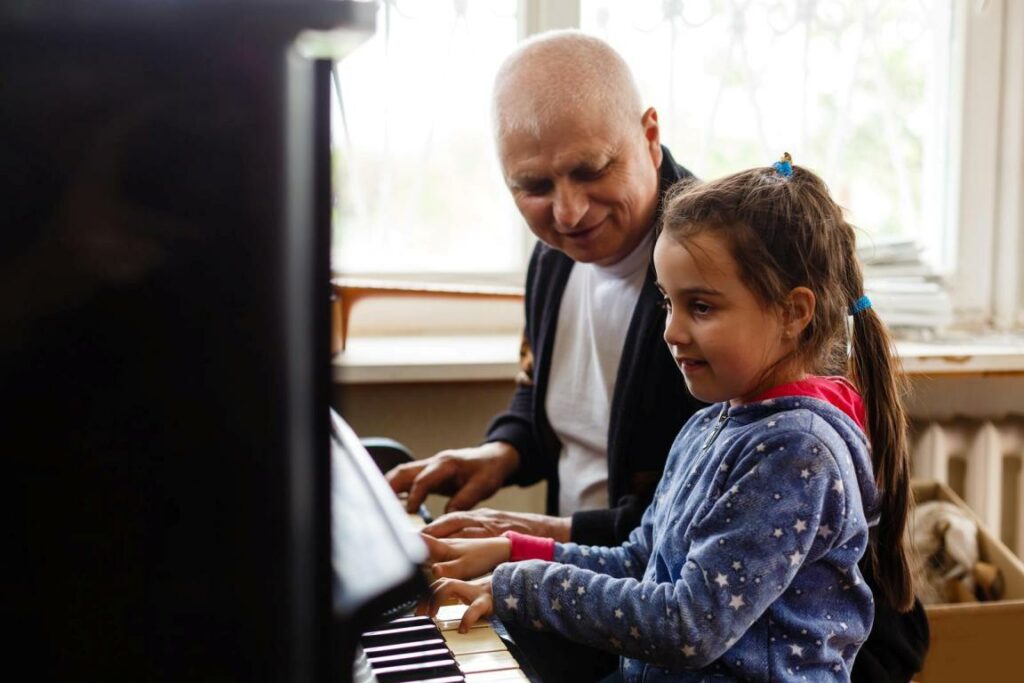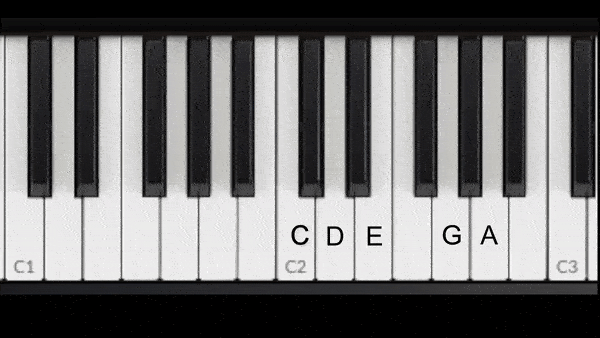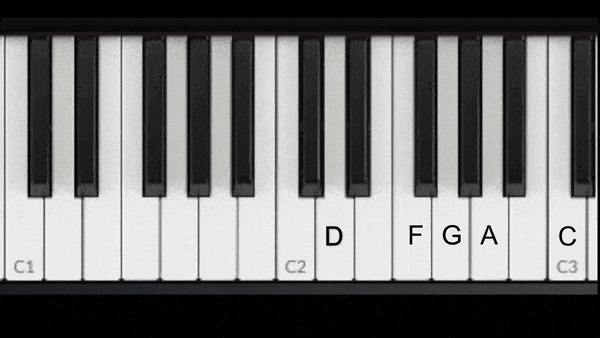Over the years I’ve taught hundreds of students to play songs on the piano. Some work from sheet music, but others prefer to learn by ear. Although both approaches are fine if you practice the song properly, I firmly believe everyone should try learning songs by ear as part of their practice routine.
This is because developing a good musical ear can develop your creativity with songs and perform with better feel, especially when you play the melody. Consequently you are able to build up a large repertoire of songs which you can play anytime from memory without the need for sheet music.
In this article, let’s look at a 6 step strategy for learning pop songs by ear on the piano. If you stick with this method, over time you will get better at this process and find it easier.
Step 1 – Listen to the song
Ok, I might sound like a school teacher screaming at an unruly class, but “listening” is crucial to playing songs by ear. And I just don’t mean just listen to the song once and be done with it. There are two types of listening to music that you need to understand; passive listening and active listening.
Passive listening
Passive listening is what most people do, especially non-musicians. You listen to a song in the car, or when you’re having a meal and it’s just there in the background.
Active listening
Active listening is when you really focus on the music you’re listening to. You do this by honing in on the various elements that make up a song; the melody, the lyrics, the chords, the guitar, the bass, the drums, the piano and anything else you can hear.
Now this isn’t easy when you’re starting out, but it gets easier with practice. You’ll want to focus on one element each time you listen to a song.
You need to do active listening if you’re learning a song by ear.
Here is the process you should follow:
- Find the song you want to play on www.ultimateguitar.com (or a similar site to find chords and lyrics). You’ll want to see the lyrics and chords together on the same page.
- Listen to the song with lyrics in front of you and hum or sing along with the vocalist. I always use YouTube for this.
- Listen again with lyrics in front of you but this time focus on the chord changes. I would pretend to play the chords on the piano as you hear the chord changes. Do any chords change on a particular word in a phrase? Or do they occur before or after any words? Chord changes usually occur in a regular pattern in most songs so it shouldn’t be too hard to figure out.
- Repeat steps 2) and 3) a couple more times.
Your aim with active listening is that you can almost run through the whole song in your head. Can you hear the singer’s voice when you think of the song, as well as the chord changes?
Step 2 – Play the chords

If you’ve done the listening stage properly, overall the rest of the process is a little easier. Let’s look at the chords next.
- Work out the chords for the song. For most songs, it’s usually a case of playing simple major and minor chords. But some songs may have more advanced chords such as 7th chords (you can play these if you feel confident enough but don’t worry if this is too hard).
- If you see major 7th chords e.g. Cmaj7 or C∆7, or if you see dominant 7th chords, e.g. C7, you can just play a major chord.
- If you see minor 7th chords e.g. Cm7, C-7 or Cmin7, you can just play a minor chord.
- Once you have worked out the chords, start playing the chord progression of the song in your left hand by yourself. Do this several times.
- Then play these chords along with the song (again in the left hand) If this is too hard, then you can slow it down (This is why I use YouTube as you can click the little cog wheel in the bottom right of the video and change the speed in the playback setting).
Step 3 – Improvise with the song

A lot of people miss out this step but I believe it’s crucial to getting a feel for the melody. Here’s what you do:
- Work out the main chord for the song. This is usually the first chord in a chord progression (but it can be the last one) Use your ear and choose the one which ‘feels like home’.
- You’re going to work out the pentatonic scale (a 5-note scale) based on this chord and play it in the right hand. There are 2 different ways to do this and you can use whatever is easier for you; one based on the major scale, or one based on intervals and the chord itself. Let me explain more below.
For a major chord
- For a major chord, think of the major scale of the same name and only play the notes 1,2,3,5 and 6. e.g. for a C major pentatonic scale = C, D, E, G and A.
- The other way is to think of the 3 notes in the chord itself and just add 2 more to get your major pentatonic scale. Take the major chord and add a note exactly in between the bottom and middle note (2 semi tones or 2 mini steps going up or down the white and black keys). Then you add a note above the top note of the chord (1 tone or 2 mini steps going up the white and black keys)

For a minor chord
- For a minor chord, think of the natural minor scale of the same name and only play the notes 1,3,4,5 and 7. e.g. for a D minor pentatonic scale = D, F, G, A and C
- The other way is to think of the 3 notes in the chord itself and just add 2 more to get your minor pentatonic scale. Take the minor chord and add a note exactly in between the middle and upper note (2 semi tones or 2 mini steps going up or down the white and black keys). Then you add a note above the top note of the chord (3 semi tones or 3 mini steps going up the white and black keys)

This may all sound complicated, but eventually you’ll get used to the sound of major and minor pentatonic scales and you’ll be able to work them out faster.
TIP – The bass intro for ‘My Girl’ by The Temptations uses the notes of the major pentatonic scale!
Once you’ve worked out the pentatonic scale, play around with these notes along with the song! This is quite a fun exercise and it has 2 benefits. Firstly you’re improvising which is a great skill to develop on the piano anyway if you want to add your own solos.
Secondly, you’ll hear the singer use a lot of these notes (most pop songs use the notes of the pentatonic scale in the melody) which will help you work out the melody of the song. Let’s look at this next.
Step 4 – Work out the melody

This is the hardest part of the whole process. Melodies are hard to work out because singers can add little notes and inflections in their vocals, and play around with the phrasing.
In some ways, you could argue it’s a lot easier to play melodies from sheet music if you can read notation. However, in sheet music, melodies are usually written too precisely, so if you copy what’s written it can sound a bit robotic and you lose any feel when you play the song! Playing the melody by ear will help you play with better feel.
My best tip for playing the melody is don’t aim for perfection. Think of your right hand as the singer’s voice and play what feels right. If you’ve listened to the song enough up till now, worked out the right pentatonic scale, you’ll play something close enough and if it sounds right to you, it will probably be fine.
Just be patient with this part of the process. You will probably need to loop certain sections in the music a lot, but the more you do this, the easier it gets.
Work out the melody in sections; verse, pre-chorus and then the chorus.
Step 5 – Play the chords and melody together
Now we can start adding the two hands together. Play the chords in the left hand along with the melody in the right hand. Play by yourself first and then try playing along with the song (you will definitely need to slow it down a bit as it will be a bit overwhelming doing this at full speed in the beginning!)
Step 6 – Add advanced techniques and make it your own

On to the last step now, which is to take the song and make it your own. This will involved adding additional techniques, being creative and just having fun with it! (I show how to add more advanced techniques in my online course). You can look on YouTube and type in [name of your song + piano cover] to get some ideas.
Conclusion
So there you have it, a six step process to work out most songs on the piano. Notice I’ve said “most” songs because although this method will usually work, for more advanced songs it will be trickier. More sophisticated pop songs may use different chord progressions throughout the song, they may change key or change style, which can make playing by ear more challenging.
In all honesty, the best way to become a complete piano player is to be able to play by ear AND read sheet music, because then you can play almost any song you like with great feel and in your own style. Although reading sheet music can put off a lot of students, it’s not as scary as you think.
For pop songs, you don’t even need to learn the left hand. You can play from something called a “lead sheet’ which is just the written out melody and the chord symbols above. That’s all you need. But to get started playing simple songs, I would argue that playing by ear should be your goal in the beginning. Reading sheet music can come later.
Related Post: How Do You Learn Songs On The Piano Faster?

Martyn Croston has over 20 years experience teaching the piano. He specialises in teaching popular music and songs, showing students how to play chords and develop their own style.


0 Comments